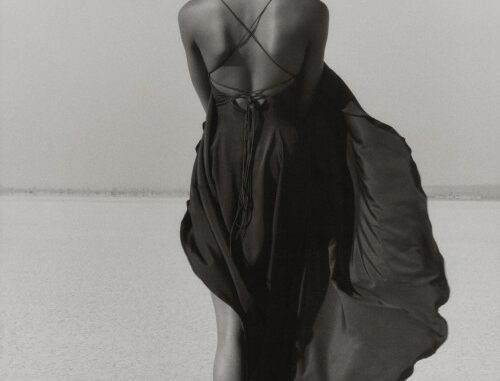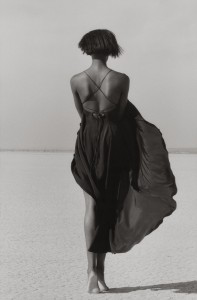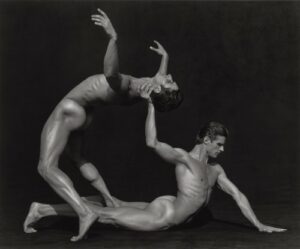

When President Obama announced on May 9, 2012 that he supports same- sex marriage, the current exhibition “Herb Ritts L.A. Style” at the J. Paul Getty Museum gets a whole new meaning. It showed how Herb Ritts – fashion, celebrity, and nude photographer (1952-2002) – bridged the gap between art and commerce. Not only is Ritts important in the art world community, his progressive actions in the 1980s and 90s helped pave the way to today’s world, where African Americans are on the top and same-sex marriage is possible.
It is for these reasons that curator Paul Martineau drew attention to Ritts’ role as a supporter of people discriminated against in society. “Ritts began using African American models at a time when some magazine editors were reluctant to use them. The strength of his work with models such as Karen Alexander and Naomi Campbell encouraged editors to use these photographs in greater numbers and in more significant ways,” Martineau says.
Instead of segregation, Ritts’ nude shot of the five supermodels Stephanie Seymour, Cindy Crawford, Christy Turlington, Tatjana Patitz, Naomi Campbell (which was sold at Sotheby’s in New York in 2007 for $ 109,000 ) implies integration. This group image presents model Naomi Campbell as she sits on the floor with the four other models, all huddled together and embracing one another. In another photograph of Naomi Campbell in the Mojave Desert, rather than showing oppression Ritts’ proposes freedom in the shot, which was taken from behind as Campbell walks leisurely on the tips of her toes in the sand lifting up her flowing, backless dress.
Among the 113 of Ritts’ work displayed at the Getty including books, magazines and photographs (the latter ranging in price between $ 20,000 – $150, 000 according to Edwynn Houk Gallery, the representative of the Ritts estate in New York) is DUO, Ritts’ third published book that features pictures of bodybuilder Bob Paris and his lover Rod Jackson. Although these photographs are not considered to be Ritts best work, the project itself is significant, “it’s the first picture book that shows gay love in a very tender and loving way”, Martineau explains. The royalties from the sales of DUO went to the American Foundation for AIDS Research. Furthermore, Ritts appeared on the Emmy-nominated television program First Person with Maria Shriver in 1993, in an episode titled “The Gay 90s: Sex, Power and Influence”, where Ritts provided encouragement for the gay and lesbian community.
As the exhibition’s title implies, “Ritts had a love for light and location,” Martineau says, so what better location to honor his work than the Getty Center, with its hilltop site in the Santa Monica Mountains and the bright California sunlight bouncing off the Center’s beige-colored travertine? Ritts enjoyed working during the “golden hour” of the first and last light of the day, and incorporated the natural environment in his photography. Ironically the desert, which was his favorite location to shoot in, turned out to be his destiny. Diagnosed with AIDS in 1989, Ritts’ immune system became weakened and he died suddenly in 2002 from the dust he was exposed to during a photo shoot for Vanity Fair with actor Ben Affleck in the dry lake bed in El Mirage, California.
Another special aspect of the exhibition is that “about 20 percent of the photographs were either unpublished or published once in a magazine or fashion catalogue and never seen again,” says Martineau, who carefully selected these photographs from Ritts’ entire archive with the help of the Herb Ritts Foundation. Among these are a photo of Tatjana Pavitz with her eyes closed and an image of Cindy Crawford in a velvet gown on a Malibu beach, which is also used on the banner ads for the Getty Center displayed throughout Los Angeles.
Martineau tried to keep a balance between the iconic pictures that everyone knows and those which are lesser known, because what would a Herb Ritts exhibition be without his famous pictures of Richard Gere and Madonna, particularly because they helped his breakthrough as a photographer and music video director. The famous image of Richard Gere as an American hero at a San Bernadino gas station was published in Mademoiselle, Vogue and Esquire within the same month and subsequently provided Ritts with many more job offers. Ritts’ photograph of Madonna with her head thrown back, her shoulders bare, dressed in a black leather jacket was used on the cover of the singer’s “True Blue” album and made her want to continue working with Ritts. She went on to convince him to start directing music videos so it is therefore not surprising to find a Madonna’s music video for the song “Cherish” among the five that are screened. Ritts shot a total of thirteen music videos over the course of his career and the exhibit also includes one for “Wicked Game” by Chris Isaak that Ritts directed. The video presents Helena Christensen on a black lava beach on Hawaii. It was aired on MTV and received the Best Male Video and Best Cinematography awards at the MTV Video Music Awards in 1991. There is also a Janet Jackson video for which Ritts had Jackson perform in a more sexually aggressive way as she sings “Love Will never Do, Without You.”
“Ritts had a relaxed relationship with celebrities,” Martineau says. He worked with many famous people, such as Michael Jackson, Sinéad O’Connor, Elton John, Karl Lagerfeld, Jean-Paul Gaultier, George Clooney, Mel Gibson and so on. Coming from a wealthy family in Brentwood, Ritts grew up next door to celebrities; Steve McQueen was his neighbor. Therefore dealing with fame and large amounts of money came naturally to him, and seems to have contributed to his incredible success.
To do justice to his legacy, the Getty also showcases some of the 50 commercials Ritts made during his career for brands such as Lancôme, Cavin Klein, Levi Strauss and Guess, all incorporating the same aesthetics that he used in his photography.

A separate section of the exhibition is devoted to Ritts’ nude shots of athletes and dancers, curated by Martineau with the question as to whether one can tell which photographs were created for his personal projects or for commercial, commissioned work. “The Art and Commerce” section reveals Ritts’ fascination with beautiful bodies that are shaped naturally through athletes’ and dancers’ work. Among them are images of Bill T. Jones, while he danced against a pristine white background. He photographed Olympic gold-medalist Greg Louganis with a low spotlight placed on him, as well as Michael Jordan, Magic Johnson, Jackie Joyner-Kersee and the acrobat duo Pierre and Yuri among others.
Ritts, who admired painter Salvador Dali and photographers Man Ray and Paul Outerbridge liked to integrate surrealist elements in his nude and fashion shots. Thus, Martineau included a nude shot of actress Stephanie Seymour, where her hair is wrapped around her face (in Mask, Hollywood, 1989), giving her the appearance of a ghost or bog mummy. There is also a picture of actor Djimon Hounsou presented with his bare torso and a dead octopus on his head.
“Even if Ritts was told to do something in a certain way, he followed his inner compass” Martineau says. That Ritts had a mind of his own becomes apparent again in his fashion work. The exhibition holds two of Ritts’ most stunning fashion pictures taken for Versace in 1990 in the dry lake bed in El Mirage. One of them presents model Christy Turlington surrounded by a tarp blown out to create a black tunnel-like shape. The other presents Naomi Campbell with her dress flipped over her head. Within the fashion section are also some of Ritts’ striking Valentino images, including one of a male model walking down a staircase in a dramatic set-up, the upper part of his body and head are covered by shade.
As a whole, the exhibition express Ritts’ great appreciation of beauty and elegance, his interest in Renaissance sculpture, his love for Old Hollywood, particularly the aesthetics of Film Noir with its use of chiaroscuro and elements of German expressionism, but also his ability to embrace and not to reject the differences among human beings.
Herb Ritts: L.A. Style” opened on April 3 and is at the J. Paul Getty Museum through August 26, 2012
– Simone Kussatz –

Leave a Reply